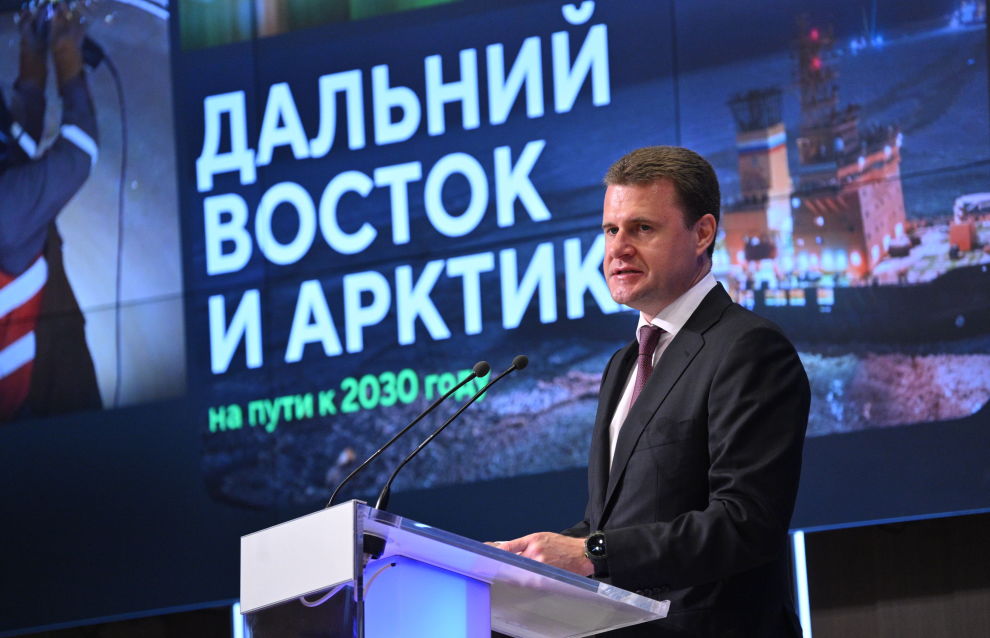Board of the Ministry for the Development of the Russian Far East and the Arctic Holds a Meeting in Moscow
The participants of an expanded meeting of the board of the Ministry for the Development of the Russian Far East and the Arctic summed up the performance in the Arctic over the past ten years. Minister Alexei Chekunkov delivered a report.
He noted that 136 large investment projects worth 9.4 trillion roubles were being implemented in the Russian Far East and the Arctic.
Industrial Growth
In all, the Ministry is overseeing 3,779 investment projects worth 11.5 trillion roubles that are supported by the government. Of these, 5.5 trillion has been invested, 1,157 new enterprises have been put into operation, and 177,000 new jobs have been created. In 2024 alone, 827 billion roubles will be invested in the projects in the Russian Far East and the Arctic.
Assets worth over 5 trillion roubles as part of the special administrative district on Russky Island were returned to Russia, and tax revenue exceeded 30 billion.
VEB.RF Bank supported 56 projects with a total financing volume in the amount of 1.6 trillion roubles. The focus of state support is shifting towards high-tech sectors and high-productivity jobs.
NSR and Transportation Infrastructure
In 2024, transportation along the Northern Sea Route set an all-time record of 37.9 million tonnes.
A federal law on the Northern Sea Route came into effect on April 1, 2024. It concerns residents of 21 Russian regions.
“Society has high expectations believing that this law will make the delivery of goods to hard-to-reach and remote areas faster, more predictable, and most importantly, make goods cheaper for northerners to buy,” the Minister noted.
The development of infrastructure of BAM and Trans-Siberian Railway, Far Eastern sea ports and checkpoints to ensure throughput capacity of at least 270 million tonnes by 2032 continues.
The regions of the Far Eastern Federal District and the Arctic are connected by 396 air routes. About 2.6 million passengers have taken advantage of tickets at subsidized prices. The air fleet is being renewed using domestic equipment.
Energy
New generation sources - TPPs, SPPs, WPPs and NPPs - with a total capacity of 3.7 - 6 GW will have been built by 2030.
Since 2017, the Far Eastern surcharge on electricity tariffs has been in effect, saving about 300 billion roubles. However, it will taper off and eventually be abolished in 2028 to be replaced by market pricing mechanisms.
Demography and Migration
The population grew in four regions of the Far Eastern Federal District, namely, Yakutia and the Amur, Magadan, and Sakhalin regions. The birth rate in the Russian Far East exceeded the national average by 11 percent to 9.3 per 1,000 people.
Almost 4,000 families received payments under the One Million for the Third Child program, which accelerated the growth of large families, especially in the Primorye Territory. The program has been extended to include seven more regions.
Under the federal program, 25,000 children from the Arctic spent their summer vacations at domestic health resorts in 2022-2024.
In 2024, migration growth was seen in 9 out of 11 regions of the Far Eastern Federal District. In total, 24,000 more people came in than went out. The leaders include the Amur Region, the Primorye Territory, and the Transbaikal Territory. For eight years, young people aged 20-24 have been steadily coming into the region.
Housing Construction and Social Infrastructure
The Far Eastern and Arctic mortgage program now extended through 2030 helped 155,000 families, including 13,000 in the Arctic, buy new homes. The construction of 1.8 million square meters of housing has begun.
In 2024, the housing commissioning amounted to 4.7 million square meters which is twice as much as five years ago. The construction of 99 sites under master plans for integrated urban development has been completed, and 63 sites more will be commissioned before the year run out.
The investment in 22 master plans of the Far Eastern Federal District amounts to 4.4 trillion roubles, in the Arctic core population centers 3.7 trillion roubles (including 2.2 trillion from extrabudgetary funds). Also approved is a plan for 30 billion roubles to renovate closed administrative territorial units in the Arctic to 2026.
Science and Human Resources
On Russky Island, the construction of a science and technology center has begun. The first phase – 7,000 square meters - will be completed by the time the Eastern Economic Forum opens. In 2025, 250 researchers will start working here, and by 2030 their number will grow to 1,000.
The implementation of the Muravyov-Amursky - 2030 program to train managerial personnel continues with 94 graduates working in the regions of the Far Eastern Federal District and the Arctic.
The Priority-2030: Far East program has tripled the inflow of students from other regions. By 2030, the number of foreign students is expected to grow by 25,000. Nearly 500 new workshops have been opened at colleges to train specialists in blue collar professions.
